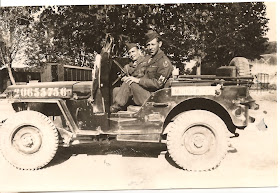The New Soper
Compendium explicitly states
that Timothy Soper is the son of Solomon Soper, who lived in Dorset
and Brandon, Vermont before moving to Canada. However, it does not
offer any sources for this information (Soper
194-5).
So,
being a good little genealogist, I have embarked on an investigation
to prove or disprove the connection.
I
will state here and now that the investigation is still underway. I
have neither proved nor disproved the hypothesis. I am creating this
post to help me remember the disparate issues I have already
uncovered and the conclusions I have thus far drawn.
Timothy
Soper does not appear in the 1851 Canadian census for the simple
reason that he died in 1847. Therefore,
I must search earlier for a record of his residence. The previous
census for which the Library and Archives Canada
has online searching capabilities is the one taken in 1842. A
search for the surname “Soper” returns four results, one of which
has the forename Timothy. (Searching for the alternate spellings
“Soaper,” “Sopper,” “Saper,” “Sopher,” and common
mis-transcription “Loper” bring no results.)
This
Timothy Soper is found in the district of Newcastle, sub-district of
Darlington. If my transcription skills in this case are to be
trusted—it was a difficult job to line up all the tallies and
identify the columns—there are five members in his household, all
Canadian natives of British origin. Two of them are single males
between the ages of 21 and 29; one is a married male over sixty, one
is a single female between the ages of 14 and 44, and one is a
married female over 45. They are all Episcopal Methodists. One of
them is engaged in trade or commerce. The family occupies 200 acres
of land, 50 of the acres improved. Details are given regarding the
amount of produce and number of livestock.
A
quick look into the History
of the Early Settlement of Bowmanville answers
the question of whether this Timothy Soper is the same as mine:
Mr.
Timothy Soper is now in his 86th
year, enjoys good health, and has lived to see every President of the
United States take their seats (Coleman 7).
As
the book was published in 1875, and my Timothy Soper died in 1847,
the Timothy Soper of Darlington cannot be mine. Moreover, the Timothy
Soper of Darlington is said to be 86 years old, giving an approximate
birth year of 1789, whereas my Timothy Soper was born in about 1773.
In
addition to all that, the Timothy Soper of Darlington was still
living in that area in 1875, while mine had arrived in Kitley—about
four counties away—by 1838 at the latest.
But
1838 is before 1842; he should appear in the 1842 census.
Unfortunately, it is not a fully nominal census: it names only the
heads of households. The
other three Sopers who showed up in the search are a James Soper of
the Niagara district and Rainham sub-district and a Levis Soper and a
Susan H. Soper, both of the London district and Bayham sub-district.
My
Timothy Soper would have been about 69 years old in 1842. Since he is
not named as a head of household, he is probably living with one of
his children. The only Soper household with a male of the proper age
is the aforesaid Timothy Soper of Darlington, whom we have already
established is not the right person.
Perhaps
my Timothy Soper is living with a married daughter. Or perhaps the
census returns for Kitley have not survived. I know that it was
located within the Johnstown district, but I don’t know what
sub-district it was in. Looking at the district and sub-district
list, I see that the returns for the Augusta sub-district have
survived, but that is all. Some
of the other districts have many sub-districts listed.
Citations:
Earl
F. Soper, editor, The New Soper
Compendium
(Berne, New York: Earl F. Soper, 1989).
1842
census for Canada West (Ontario) of Canada, Ontario, Durham
county, Newcastle district,
Darlington sub-district, item no. 7384, Timothy Soper; digital
images, Library and Archives Canada, "1842 Census for Canada
West," Library and Archives Canada
(http://www.bac-lac.gc.ca/eng/Pages/home.aspx
: accessed 6 Aug 2016); citing MG 31 C1 Census of Upper
Canada, 1842, microfilm
C-1344.
J.
T. Coleman, History of the Early Settlement of
Bowmanville and Vicinity
(Bowmanville, Ontario: West Durham Steam Printing and Publishing
House, 1875).
Sources:
Ancestry.com
and Genealogical Research Library, "Ontario, Canada, Marriages,
1801-1928, 1933-1934," database, Ancestry.com Operations, Inc.,
Ancestry (www.ancestry.com
: accessed 6 Aug 2016), entry for Timothy Sopper and Martha Sopper,
16 Dec 1838; citing Archives of Ontario; Toronto, Ontario, Canada;
District Marriage Registers, 1801-1858; Series: MS248; Reel: 3.
1842
census for Canada West (Ontario) of Canada, Ontario, Haldimand
county, Niagara district, Rainham sub-district, item no. 13640, James
Soper; digital images, Library and Archives Canada, "1842 Census
for Canada West," Library and Archives Canada
(http://www.bac-lac.gc.ca/eng/Pages/home.aspx
: accessed 6 Aug 2016); citing MG 31 C1 Census of Upper Canada, 1842,
microfilm C-1344.
1842
census for Canada West (Ontario) of Canada, Ontario, London district,
Bayham sub-district, item no. 15451, Levi Soper; digital images,
Library and Archives Canada, "1842 Census for Canada West,"
Library and Archives Canada
(http://www.bac-lac.gc.ca/eng/Pages/home.aspx
: accessed 6 Aug 2016); citing MG 31 C1 Census of Upper Canada, 1842,
microfilm C-1345.
1842
census for Canada West (Ontario) of Canada, Ontario, London district,
Bayham sub-district, item no. 15455, Susan H. Soper; digital images,
Library and Archives Canada, "1842 Census for Canada West,"
Library and Archives Canada
(http://www.bac-lac.gc.ca/eng/Pages/home.aspx
: accessed 6 Aug 2016); citing MG 31 C1 Census of Upper Canada, 1842,
microfilm C-1345.













